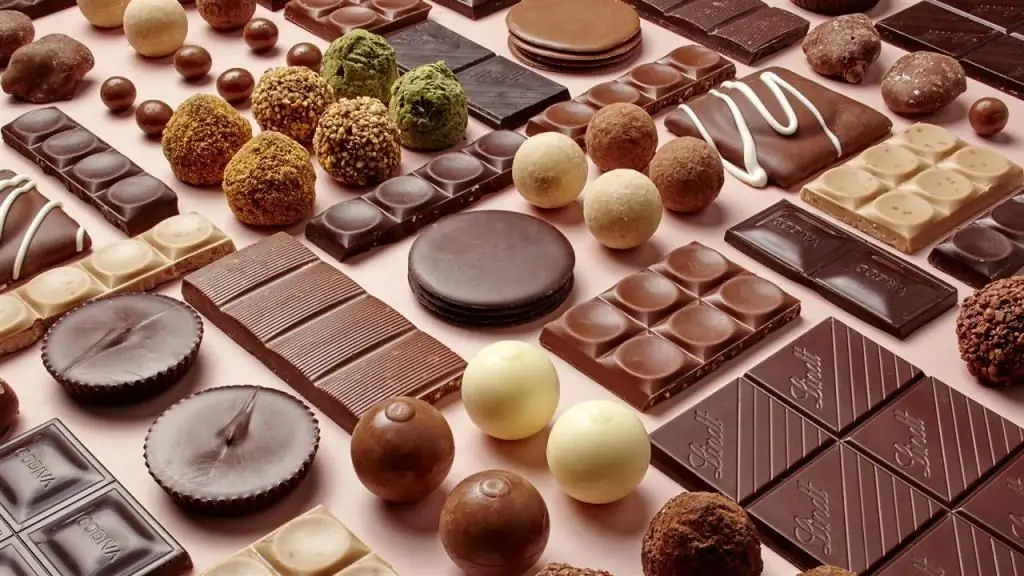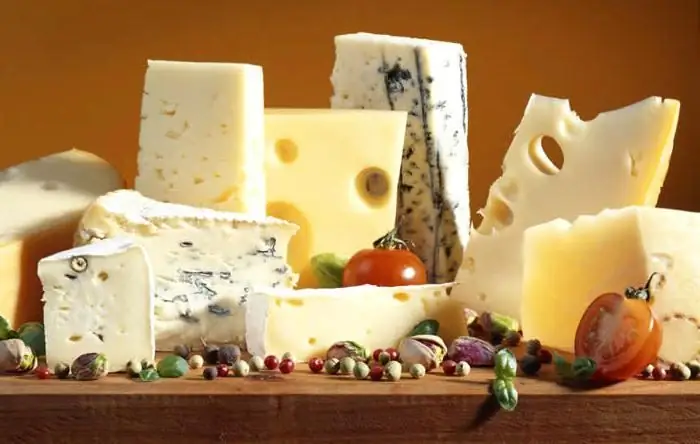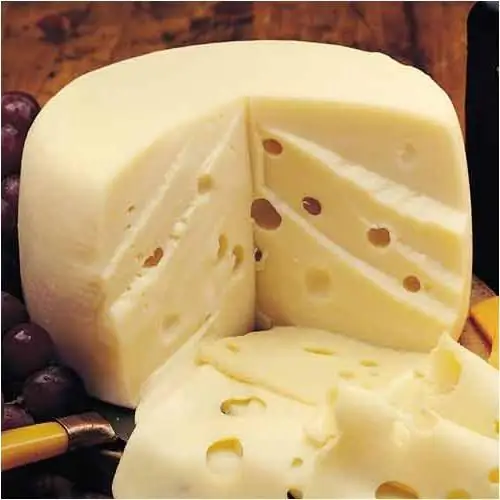2026 Author: Isabella Gilson | [email protected]. Last modified: 2025-01-23 12:50:33
Swiss cheese is respected and popular all over the world. This product is marked with a special label to confirm its quality and authenticity. Already at the end of the 18th century, cheese became one of the most exported Swiss products, and this trend is relevant today.
How is this product different from others?

Real Swiss cheeses are made from raw, most often cow's milk (goat's or sheep's milk is less commonly used). Traditionally, each region of the country produces its own variety of cheese (hence its name). A rather high percentage of this product is produced not by large enterprises, but by family businesses. For the Swiss, cheese is not just a business, it is a tradition, an integral part of life.
Swiss cheese: varieties
Depending on the ripening period, extra-hard, hard, semi-hard cheeses are distinguished. The technology of their preparation was dictated by the need to extend the shelf life of the product. It was Swiss cheeses that helped people survive the harsh winters without hunger. Variety names are almostalways associated with their geographical home (canton, valley where the village is located).
Most popular hard cheese varieties:
- Gruyère (named after the city) is produced in the five cantons of Switzerland.
- "Etiva" has a delicate aroma with hints of nuts and fruits, and even in the 21st century it is made according to the old technology - by hand. In a large cauldron (about 450 liters) suspended above the oven, the heating milk is stirred, the desired temperature is adjusted, allowed to cool, heated again and the cheese is separated for subsequent maturation.
- Swiss Alp Bellevue is made from cow's milk. Fat content - 50%. Its texture is dense, homogeneous, with a spicy crust that smells like alpine herbs. The cheese does not contain lactose, and the minimum period of its maturation is 6 months. Bellevue is perfect for a quick bite or as part of a cheese plate.

Semi-hard varieties:
- Tilsiter (Canton of Thurgau) has a light yellow color and a very delicate taste. Its structure contains small holes. This variety matures in 3-5 months. Ideal with rye bread and dark beer, salads, potatoes. Makes an unforgettable taste of a sauce or an ordinary sandwich.
- Appenzeller cheese is considered the most fragrant in the world. The severity of the spice depends on the aging period (3-8 months). It is produced in two cantons of Switzerland from fresh milk. It goes very well with pasta, as a base for cheese balls.
- "Tete de Moine" is prepared according to the traditional recipe of the monks of Belle Abbey fromwhole cow's milk. For cheese, only summer milk is used. Its taste captivates with its piquancy: subtle sharpness and barely perceptible sweetness. Fat content is 51%. The texture is dense, with a brown crust. The product ripens on spruce boards for at least 75 days, during which it is rubbed with saline solution with bacterial cultures.
Swiss extra hard cheeses:
- Sbrinz (one of the oldest varieties) is made in Central Switzerland from the raw milk of brown cows. Its fat content is 45%. Therefore, the color of the product is very yellow with a golden crust. The ripening period is impressive: from 18 to 36 months. The texture of the cheese is quite interesting: brittle, very hard, but at the same time melting in the mouth. The nutty-caramel flavor of Sbrinz is perfect with cider, wine, gourmet pizza and will add the finishing touch to any dressing or sauce.
- Hobelkese is made in the canton of Bern. The cheese is very dense, so it is cut into thin slices before use.
- "Emmental" is named after the Emme Valley in the same canton. It tastes sweet and spicy and has large holes in the texture.
Traditional cheese dishes

Swiss cheeses are the basis of the Swiss national cuisine. Fondue, raclette, cheese soufflé, polenta: all the most famous dishes of this country have them in their composition. The cheese component is felt in everything (and in casseroles, and in pies, and in soups, and in batter). Interestingly, the prototype of modern gourmet dishes was a simple shepherd's dinner: bread andcheese.
Cooking technology

Swiss cheese is also interesting because manual labor is used at many stages of production (of course, if we are talking about small family businesses, and most of them are). Cheese makers heat raw milk in a huge vat to 34 degrees. Then a special fermentation enzyme is dripped. The cheese is then separated from the whey. The product is s alted, heated again to a level of 43 degrees and pressed. The final process is the ripening of the cheese (each variety has a different shelf life and temperature).
How to distinguish real cheese from a fake?

When choosing Swiss cheeses, remember that they cannot mature for less than 3 months, have a fat content below 50%. As a rule, it has oval holes, a pronounced or slightly perceptible spicy-sweet taste. Also pay attention to the following aspects:
- the presence of the Swiss quality control mark "AOC";
- cheese crust (required for aged cheeses);
- color (the product should have a yellow, dark yellow color due to high fat content);
- expiration date (no more than a year).
What pairs with cheese from Switzerland?
Swiss hard cheeses are traditionally served with red wine, bread and vegetables. We suggest you try several options for combining this product with dishes:
- Gruyere cheese and pickled vegetables, ham.
- Emmental and potatoes, steamed vegetables.
- Tilsiter and rye bread, beer.
- Muesli (from cheeseraclette).
Making Swiss cheese is an art. This is a unique product that is popular all over the world. A variety of varieties and a delicate taste allow you to combine it with almost any product.
Recommended:
Classification of chocolate by composition and production technology. Chocolate and chocolate products

Chocolate is a product made from cocoa beans and sugar. This product, with a high calorie content and high nutritional value, has an unforgettable taste and captivating aroma. Six hundred years have passed since its discovery. During this period, it has undergone a major evolution. To this day, there are a large number of forms and types of products made from cocoa beans. Therefore, it became necessary to classify chocolate
Uns alted hard cheeses: list, taste description, production technology

Hard, uns alted cheeses have a lower moisture content than soft ones. They are usually packaged in high pressure molds and aged for longer. Cheeses that are classified as semi-hard and hard include the familiar cheddar
French cheeses and their types. Top 10 French Cheeses

Cheese is the pride of France. They are known all over the world for their unsurpassed taste and aroma
Low-calorie diet cheeses: names and varieties

We have been taught to eat cheese since kindergarten. Years go by, and the love for cheese products only grows. Now cheese is not only put on sandwiches, as in school, but also added to all kinds of salads and gourmet dishes
Finnish cheeses: "Oltermani" and other varieties

What are Finnish cheeses, what are the main types and varieties of Finnish cheeses, a description of "Oltermani" and other brands of this product

